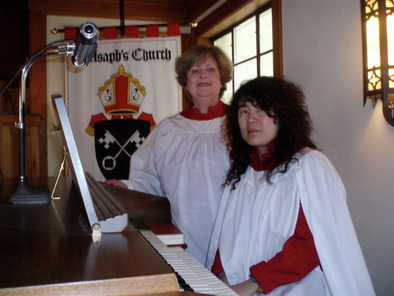The Rev. Denise Bennett, Priest-in-Charge

The Vestry of
St. Asaph's Episcopal Church
2024
Jean Young, Senior Warden
Chris Hancock, Junior Warden
Sam Frye
Catherine Gravatt
Mark Sullivan
Gary Gravatt, Treasurer
Sherry Gravatt, Register
MUSIC
A History of
St. Asaph's Episcopal Church
The roots of St. Asaph's Church go deep into the history of the colonial church. St. Asaph's is a direct descendant of Charles River, later York, Parish, which was founded in 1618 and one of the first four boroughs and also one of the eight original shires of 1634. As the colony grew, the area of the original county was divided to form New Kent, later King and Queen and King William counties, and finally, through a merger of lands in Essex, King and Queen and King William counties, Caroline County.
St. Asaph's founding took place in the revolutionary days of our country. The General Assembly of Virginia meeting in 1779 passed a resolution that on the first day of February in the next year, Drysdale parish should be divided into two distinct parishes and one should "be called and known by the name St. Asaph." Tradition holds that the name "St. Asaph's" was chosen because the bishop of the Diocese of St. Asaph's in Wales, John Shipley, was known to be sympathetic to the revolutionary cause. This was the last parish in the present Diocese of Virginia formed by the General Assembly. St. Asaph's was one of the parishes represented in the first Convention of the Church held in Virginia in 1785, setting up what was to become the Diocese of Virginia.
The parish originally met in the "Creek Church" which was a brick structure located near the homestead of Charles Broaddus in Bowling Green. Like many parishes of the former "established church" she had a fitful start until 1834 when the Reverend William Friend inspired the congregation to erect a new church in Bowling Green. The brick structure built at the same time served the Episcopalians of the community until 1876 when their number had dwindled so that the property was sold to the Southern Methodists for five hundred dollars. The few Episcopalians in the area thereafter met for worship in rented space or at the Antioch Christian Church under the name, "Trinity Mission."
The present church building was begun when the Reverend Wilson Stitt was rector in 1953. It is located just down the street from the old Bowling Green building and was dedicated in 1954, and consecrated in 1970. The brick and slate building seats one hundred people. The interior is trimmed in native oak, complementing the plaster walls and red carpeting.
The Reverend Macon Walton served the parish from 1955 to 1962. The Reverend Ralph Fall was rector from 1962 to 1982. The Reverend Donald Place was rector for five years ending in 1989.
Saint Asaph’s Parish and its church have been an independent cure since 1989. The Reverend J. Currie Carter served the parish on a part time basis until 1992, when the Reverend Doctor McAlister C. Marshall became the Rector and served until June, 2001. On April 28, 2002, the Reverend Doctor W. Pegram Johnson, III, was inducted as Priest-in-Charge and served until January 31, 2010. The Reverend Barbara C. “Bambi” Willis became Priest-in-Charge on May 1, 2011 and officially became Rector on February 2, 2014. Rev. Willis served at St. Asaph's until Nov. 13, 2016. Reverend Charles Joy, began in a temporary capacity in 2017, and is currently serving as the Priest-in-Charge.


